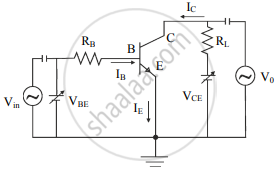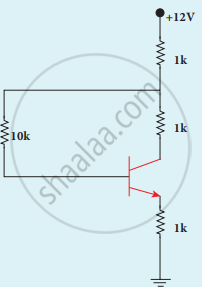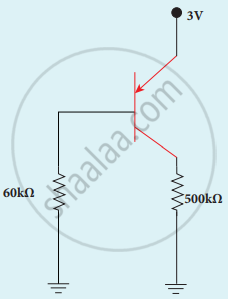Advertisements
Advertisements
प्रश्न
With the help of a neat circuit diagram, explain the transistor as an amplifier?
उत्तर
Working of an amplifier:
- The circuit of an amplifier using an n-p-n transistor in CE configuration is shown in the figure.

- When the input voltage Vin is not applied, applying the Kirchhoff’s law to the output loop, we can write, VCC = VCE + ICRL
- Similarly, for input loop,
VBB = VBE + IBRB - When the input AC signal is applied, Vin is not zero. Thus, the voltage drop across the input loop will now be,
VBB + Vin = VBE + IBRB + ΔIB (RB + ri) ....(1) - The AC signal applied adds the current of ΔIB to the original current flowing through the circuit. Therefore, the additional voltage drop in the input loop will be across resistor RB (= ΔIBRB) and across the input dynamic resistance of the transistor (= ΔIBri).
- From equation (1),
Vin = ΔIB (RB + ri)
As, RB is very small, we can consider,
Vin = ΔIBri - The changes in the base current IB cause changes in the collector current IC. This changes the voltage drop across the load resistance because VCC is constant. We can write,
ΔVCC = ΔVCE + RLIC = 0
∴ ΔVCE = -RLIC - The change in the output voltage ΔVCE is the output voltage Vo hence we can write,
Vo = ΔVCE = `beta`ACRLΔIB
APPEARS IN
संबंधित प्रश्न
Why are the emitter, the base, and the collector of a BJT doped differently?
In a common base configuration, the transistor has an emitter current of 10 mA and a collector current of 9.8 mA. The value of base current is ______
For a transistor IC = 15 mA, IB = 0.5 mA. What is the current amplification factor?
Draw the circuit symbol for NPN and PNP transistors. What is the difference in the Emitter, Base, and Collector regions of a transistor?
The output of the following circuit is 1 when the input ABC is

Explain the current flow in an NPN transistor.
Describe the function of a transistor as an amplifier with the neat circuit diagram. Sketch the input and output wave forms.
A transistor of α = 0.99 and VBE = 0.7 V is connected in the common-emitter configuration as shown in the figure. If the transistor is in the saturation region, find the value of collector current.

In the circuit shown in the figure, the BJT has a current gain (β) of 50. For an emitter-base voltage VEB = 600 mV, calculate the emitter-collector voltage VEC (in volts).

In a common emitter amplifier, the input resistance is 1000 Ω, the peak value of Input signal voltage is 5 mV, and β = 60. The peak value of output current is
In the symbol for a transistor, the arrow head points in the direction of the ____________.
Ve, Vb, and Ve are emitter, base, and collector voltage respectively for npn transistor in CE mode. Amplifier works for the combination of biasing voltage equal to ______.
If `alpha`-current gain of a transistor is 0.98. What is the value of `beta`- current gain of the transistor?
In an npn transistor, the collector current is 24 mA. If 80% of electrons reach collector, its base current in mA is ______.
ln switching circuit, transistor is in ON state and values of IC and IB are 4.2 mA and 5 µA respectively and RC= l k`Omega` and RB= 300 k`Omega`. If VBE = 0.5 V, find the value of VBB.
In switching circuit, transistor is in ON state, values of IE and lB are 10 mA and 0.8 mA respectively and RL is 2 k`Omega`. If VCE is 7.6 V, then VCC is ____________.
In a silicon transistor, a change of 7.89 mA in the emitter current if produces a change of 7.8 mA in the collector current, then the base current must change by ____________.
The current gain `alpha` of a transistor is 0.95. The change in collector current corresponding to a change of 0.4 mA in the base current in a common emitter arrangement is ______.
In a transistor, the thickness of the base region ____________.
In a transistor, doping level in base is increased slightly, the collector current and base current respectively ______.
In common emitter mode of transistor, the d.c. current gain is 20, the emitter current is 7 mA. The collector current is ______.
In common emitter amplifier, a change of 0.2 mA in the base current causes a change of 5 mA in the collector current. If input resistance is 2K `Omega` and voltage gain is 75, the load resistance used in the circuit is ______.
A common emitter amplifier has a voltage gain of 50, an input impedance of 100Ω and an output impedance of 2000Ω. The power gain of the amplifier is ______.
The reverse bias in a junction diode is changed from 8V to 13V, then the value of the current changes from 40μA to 60μA. The resistance of junction diode will be ______.
Define α.
